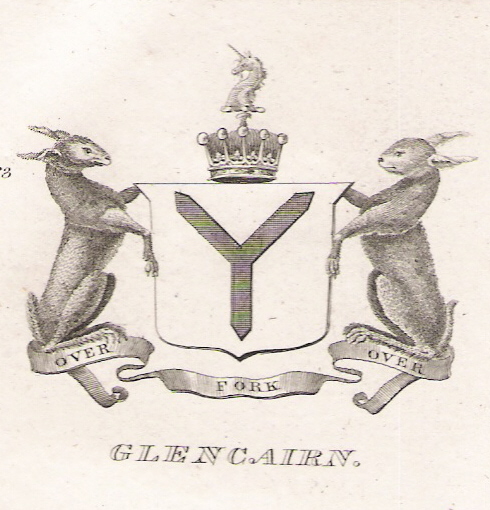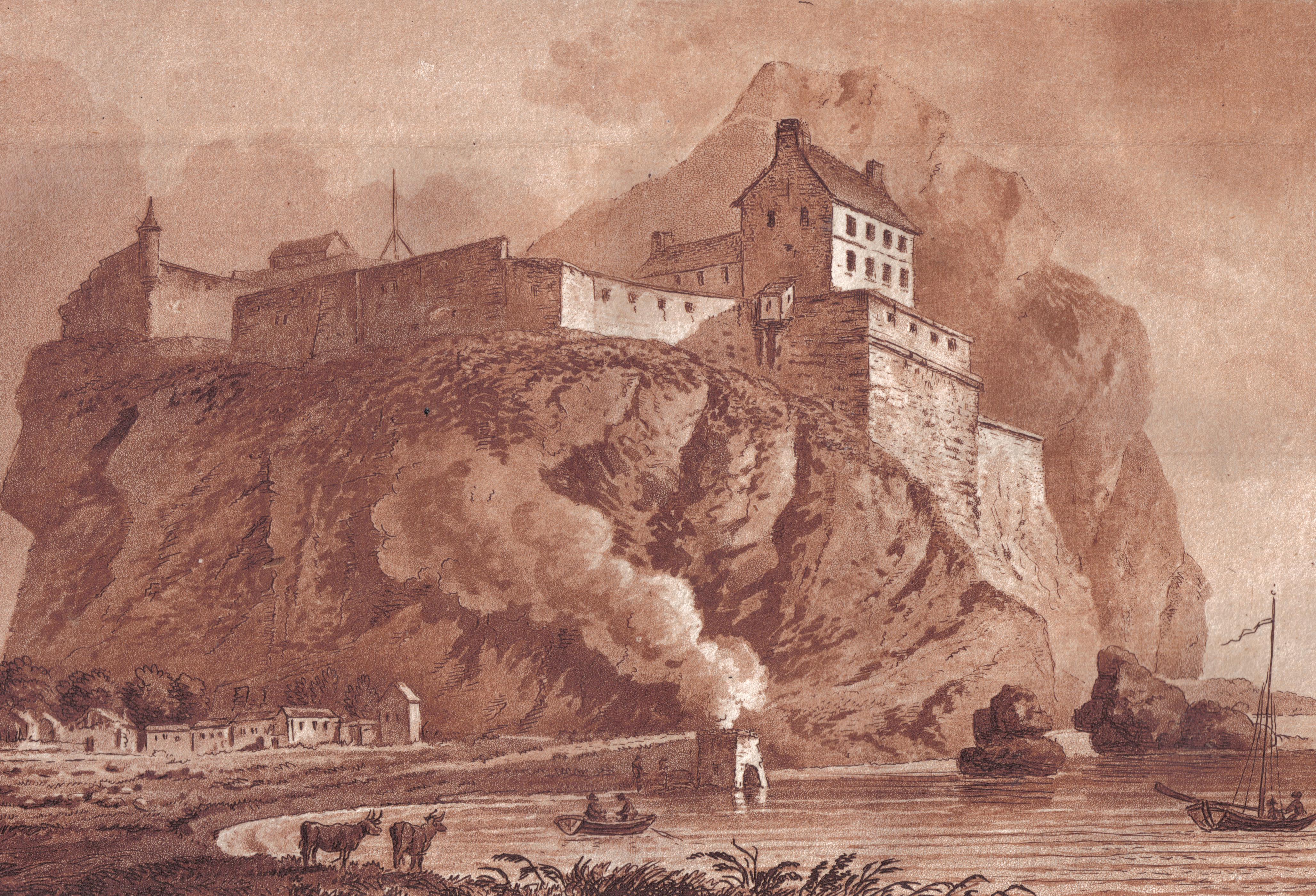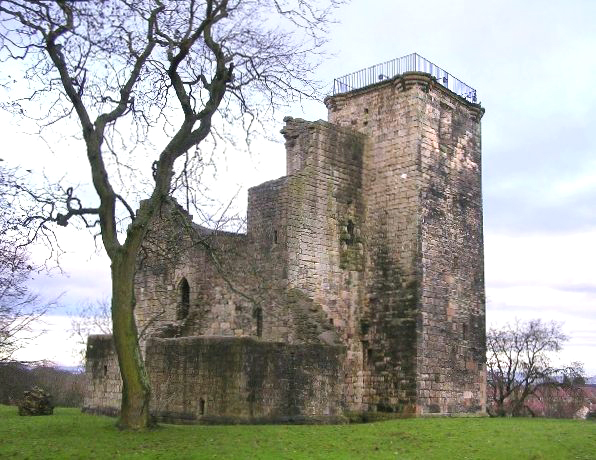|
Duchal Castle
The ruins of the large courtyard style Duchal Castle lie circa 1.5 miles south-west of Kilmacolm in the Inverclyde council area and the historic county of Renfrewshire in the west central Lowlands of Scotland. The castle stands at the bottom of the valley of the River Gryfe on a peninsula created by the Blacketty and Green Waters which have their confluence beyond the two deep gorges. History The castle was held from the 12th century by the Lyle, L'Isle, Lyell or Insula family. It seems unlikely that they were of the same Lisle family which had first settled in Northumberland. Ralph de Insula of Duchal is recorded in the reign of Alexander II (1198 – 1249) and he may have built the first castle here. In the mid 15th century Lord Lyle was ennobled by James II and a successor, Sir Robert Lyle became Lord Chief Justice and a Privy Councillor to James III. Lord Lyle had died in 1470 and his heiress had married Alexander Lyle of Craigbate. In 1513 James IV and his natural son ... [...More Info...] [...Related Items...] OR: [Wikipedia] [Google] [Baidu] |
Kilmacolm
Kilmacolm () is a village and civil parish in the Inverclyde council area, and the historic county of Renfrewshire in the west central Lowlands of Scotland. It lies on the northern slope of the Gryffe Valley, southeast of Greenock and around west of the city of Glasgow. The village has a population of around 4,000 and is part of a wider civil parish which covers a large rural hinterland of containing within it the smaller settlement of Quarrier's Village, originally established as a 19th-century residential orphans' home. The area surrounding the village was settled in prehistoric times and emerged as part of a feudal society with the parish divided between separate estates for much of its history. The village itself remained small, providing services to nearby farm communities and acting as a religious hub for the parish. The name of the village derives from the Scottish Gaelic ''Cill MoCholuim'', indicating the dedication of its church to St Columba. The parish church was ... [...More Info...] [...Related Items...] OR: [Wikipedia] [Google] [Baidu] |
Earl Of Melfort
The titles of Viscount of Melfort and Lord Drummond of Gillestoun were created in the Peerage of Scotland on 14 April 1685 for John Drummond, second son of James Drummond, 3rd Earl of Perth, with remainder to the heirs male of his body by his second marriage, to Euphemia Wallace, failing whom to the heirs male of his body whatsoever. He was further created, on 12 August 1686, Earl of Melfort, Viscount of Forth and Lord Drummond of Riccartoun, Castlemains and Gilstoun, also in the peerage of Scotland, and with a similar remainder. A supporter of King James II and VII, Melfort escaped to France on 16 December 1688, following the " Glorious Revolution" which installed William of Orange and Mary II on the English and Scottish thrones. Drummond was further created ''Baron Cleworth'' in the Jacobite Peerage of England by the exiled monarch, on 7 August 1689, and ''Duke of Melfort'', ''Marquess of Forth'', ''Earl of Isla and Burntisland'', ''Viscount of Rickerton'' and ''Lord Castlema ... [...More Info...] [...Related Items...] OR: [Wikipedia] [Google] [Baidu] |
Covenanter
Covenanters ( gd, Cùmhnantaich) were members of a 17th-century Scottish religious and political movement, who supported a Presbyterian Church of Scotland, and the primacy of its leaders in religious affairs. The name is derived from '' Covenant'', a biblical term for a bond or agreement with God. The origins of the movement lay in disputes with James VI, and his son Charles I over church structure and doctrine. In 1638, thousands of Scots signed the National Covenant, pledging to resist changes imposed by Charles on the kirk; following victory in the 1639 and 1640 Bishops' Wars, the Covenanters took control of Scotland and the 1643 Solemn League and Covenant brought them into the First English Civil War on the side of Parliament. Following his defeat in May 1646 Charles I surrendered to the Scots Covenanters, rather than Parliament. By doing so, he hoped to exploit divisions between Presbyterians, and English Independents. As a result, the Scots supported Charles in the ... [...More Info...] [...Related Items...] OR: [Wikipedia] [Google] [Baidu] |
Rowallan Castle
Rowallan Castle (Scottish Gaelic: ''Caisteal an Rubha Àlainn'') is an ancient castle located in Scotland. The castle stands on the banks of the Carmel Water, which may at one time have run much closer to the low eminence upon which the original castle stood,Miller, A. H. (1885). ''The Castles and Mansions of Ayrshire''. Reprinted by The Grimsay Press, 2004. P. 128. justifying the old name Craig of Rowallan. Elizabeth Mure (died before May 1355) was mistress and then wife of Robert, High Steward of Scotland, and Guardian of Scotland (1338–1341 and from October 1346), who later became King Robert II of Scotland. She may have been born at Rowallan. The history of Rowallan Castle Owners The castle and barony has been owned or held by the medieval Muir family, the (Boyle) Earls of Glasgow, the (Campbell) Earls of Loudoun, and the (Corbett) Barons Rowallan. In 1989, it returned to the Campbell family when it was purchased by Niall Campbell.http://www.scotsman.com/lifestyle/heri ... [...More Info...] [...Related Items...] OR: [Wikipedia] [Google] [Baidu] |
Barony Of Bonshaw
The Barony of Bonshaw, previously known as Bollingshaw, was in the old feudal Baillerie of Cunninghame, near Stewarton in what is now North Ayrshire, Scotland. The History of Bonshaw The Irvines and Boyds William Irvine (c.1298) (also known as William de Irwin) was a clerk in the royal chancellery and protégé of Bernard, Abbot of Arbroath and Chancellor of Scotland; he was granted land in Aberdeenshire in 1323 by Robert the Bruce for faithful service. This grant included a defensive work known as the Drum Tower, thus William became the first Laird of Drum. The family had previously held the lands of Bonshaw and took their name from the village of Irvine in Annandale.Strawhorn, John (1985). ''The History of Irvine.'' Pub. John Donald. . p. 4. Drum Castle, Aberdeenshire An Irvinehill Farm is still to be found near Kennox which may relate to this family name or may simply signify that a good view of Irvine is to be had from this eminence. Alexander Smith (died 1938) and his s ... [...More Info...] [...Related Items...] OR: [Wikipedia] [Google] [Baidu] |
Earl Of Glencairn
Earl of Glencairn was a title in the Peerage of Scotland. It was created in 1488 for Alexander Cunningham, 1st Lord Kilmaurs (created 1450). The name was taken from the parish of Glencairn, Dumfries and Galloway, Glencairn in Dumfriesshire so named for the Cairn Waters which run through it. On the death of the fifteenth earl in 1796, there existing no original Letters Patent of the creation nor a given remainder in the various confirmations in title of previous earls the title became dormant The earldom was claimed by Sir Adam Fergusson, 3rd Baronet, Sir Adam Fergusson of Kilkerran, Bt., as heir of line of Alexander 10th, Earl of Glencairn and was opposed by Sir Walter Montgomery Cunningham of Corshill, Bt., as presumed heir male along with Lady Henriet Don, sister of the last earl, and wife of Sir Alexander Don of Newton Don, Roxburghshire. The House of Lords Committee of Privileges on 14 July 1797, chaired by the Lord Chancellor (Alexander Wedderburn, 1st Earl of Rosslyn, Lord ... [...More Info...] [...Related Items...] OR: [Wikipedia] [Google] [Baidu] |
Dumbarton Castle
Dumbarton Castle ( gd, Dùn Breatainn, ; ) has the longest recorded history of any stronghold in Scotland. It sits on a volcanic plug of basalt known as Dumbarton Rock which is high and overlooks the Scottish town of Dumbarton. History Dumbarton Rock was formed between 330 and 340 million years ago, during the Early Carboniferous period, a time of widespread volcanic activity in the area where Glasgow is now situated; over time, the softer exterior of the volcano weathered away, leaving behind a volcanic plug of basalt. Iron Age At least as far back as the Iron Age, this has been the site of a strategically important settlement, as evidenced by archaeological finds. The people that came to reside there in the era of Roman Britain were known to have traded with the Romans. However the first written record about a settlement there was in a letter that Saint Patrick wrote to King Ceretic of Alt Clut in the late 5th century. Early Medieval era David Nash Ford has propos ... [...More Info...] [...Related Items...] OR: [Wikipedia] [Google] [Baidu] |
Crookston Castle
Crookston Castle is a ruined medieval castle in the Pollok area of Glasgow, Scotland. It is located some 5 miles (8 km) south-west of the city centre, on a hill overlooking the Levern Water, just before its confluence with the White Cart Water. Crookston Castle was built by the Stewarts of Darnley around 1400, and is set within earthworks constructed in the 12th century. Once the property of the earls and dukes of Lennox, the castle was extensively repaired following a siege in 1544, and it is the only surviving medieval castle in Glasgow. History Crookston is surrounded by a defensive ring ditch that dates back to the 12th century when Sir Robert de Croc, who also gave his name to the village of Crookston, built a timber and earth castle. Remains of a chapel founded by de Croc in 1180 have been uncovered. Evidence of an even earlier fortification on the same site has also been found. The lands of Crookston were bought by Sir Alan Stewart in 1330, and passed to Sir ... [...More Info...] [...Related Items...] OR: [Wikipedia] [Google] [Baidu] |
Mons Meg
Mons Meg is a medieval bombard in the collection of the Royal Armouries, on loan to Historic Scotland and located at Edinburgh Castle in Scotland. It has a barrel diameter of making it one of the largest cannons in the world by calibre. Mons Meg was built in 1449 on the orders of Philip the Good, Duke of Burgundy and sent by him as a gift to James II, King of Scots, in 1454. The bombard was employed in sieges until the middle of the 16th century, after which it was only fired on ceremonial occasions. In 1680 the barrel burst, rendering Mons Meg unusable. The gun remained in Edinburgh Castle until 1754 when, along with other unused weapons in Scotland, it was taken to the Tower of London. Sir Walter Scott and others campaigned for its return, which was effected in 1829. Mons Meg has since been restored and is now on display within the castle. Construction The bombard was manufactured from longitudinal bars of iron, hooped with rings fused into one mass. The barrel is ... [...More Info...] [...Related Items...] OR: [Wikipedia] [Google] [Baidu] |
Battle Of Sauchieburn
The Battle of Sauchieburn was fought on 11 June 1488, at the side of Sauchie Burn, a stream about south of Stirling, Scotland. The battle was fought between the followers of King James III of Scotland and a large group of rebellious Scottish nobles including the future Alexander Home, 2nd Lord Home, who were nominally led by the king's 15-year-old son, James, Duke of Rothesay. James III was killed in the battle, and his son succeeded him as James IV. Father and son James III had faced rebellion for months, with a complicated series of events leading to Sauchieburn. The rebels having made James, Duke of Rothesay their figurehead earlier in the year, James III became determined to get hold of his son and settle the matter. However he broke his written word that he would negotiate first, instead travelling south to Edinburgh from his stronghold in the north. This breaking of his word apparently caused some of his strong supporters to desert him, such as Huntly, Erroll, Marish ... [...More Info...] [...Related Items...] OR: [Wikipedia] [Google] [Baidu] |





